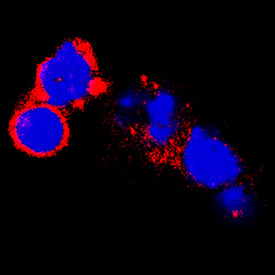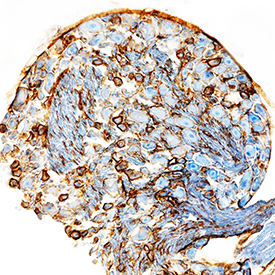Human/Mouse GFR alpha-2/GDNF R alpha-2 Antibody Summary
5% cross‑reactivity with recombinant human GFR alpha -3 is observed.
Ser22-Ser441
Accession # Q3UUD8
Applications
Please Note: Optimal dilutions should be determined by each laboratory for each application. General Protocols are available in the Technical Information section on our website.
Scientific Data
 View Larger
View Larger
GFR alpha ‑2/GDNF R alpha ‑2 in Mouse Splenocytes. GFRa-2/GDNF Ra-2 was detected in immersion fixed mouse splenocytes using Goat Anti-Human/Mouse GFRa-2/GDNF Ra-2 Antigen Affinity-purified Polyclonal Antibody (Catalog # AF429) at 5 µg/mL for 3 hours at room temperature. Cells were stained using the NorthernLights™ 557-conjugated Anti-Goat IgG Secondary Antibody (red; Catalog # NL001) and counterstained with DAPI (blue). Specific staining was localized to plasma membrane. View our protocol for Fluorescent ICC Staining of Non-adherent Cells.
 View Larger
View Larger
GFR alpha ‑2/GDNF R alpha ‑2 in Mouse Dorsal Root Ganglion. GFRa-2/GDNF Ra-2 was detected in perfusion fixed frozen sections of mouse dorsal root ganglion using Goat Anti-Human/Mouse GFRa-2/GDNF Ra-2 Antigen Affinity-purified Polyclonal Antibody (Catalog # AF429) at 1.7 µg/mL overnight at 4 °C. Tissue was stained using the Anti-Goat HRP-DAB Cell & Tissue Staining Kit (brown; Catalog # CTS008) and counterstained with hematoxylin (blue). Specific staining was localized to plasma membrane of sensory neurons. View our protocol for Chromogenic IHC Staining of Frozen Tissue Sections.
Reconstitution Calculator
Preparation and Storage
- 12 months from date of receipt, -20 to -70 °C as supplied.
- 1 month, 2 to 8 °C under sterile conditions after reconstitution.
- 6 months, -20 to -70 °C under sterile conditions after reconstitution.
Background: GFR alpha-2/GDNF R alpha-2
Glial cell line-derived growth factor (GDNF), neurturin (NTN), persephin (PSP) and artemin, distant members of the TGF-beta superfamily, are neurotrophic factors for a variety of neuronal populations in the central and peripheral nervous systems. The bioactivities of GDNF and NTN are mediated through a receptor complex composed of the non ligand-binding signaling subunit (c-Ret receptor tyrosine kinase) and either of two ligand binding subunits, GDNF receptor alpha -1 (GFR alpha -1, also known as Trn R1) or GFR alpha -2 (also known as Trn R2). GFR alpha -1 and -2 are members of a family of at least four cysteine-rich glycosyl-phosphatidylinositol (GPI)-linked cell surface proteins that share conserved placements of many of their cysteine residues. Binding of GDNF or NTN to membrane-associated GFR alpha -1 or GFR alpha -2 initiates the association with and activation of the Ret tyrosine kinase.
Mouse GFR alpha -2 cDNA encodes a 463 amino acid (aa) residue protein with a putative N-terminal 21 aa residue hydrophobic signal peptide. Like other GPI-linked proteins, rat GFR alpha -2 has a C-terminal hydrophobic region which is preceded by a 3 aa residue (SGS) GPI-binding site. Human GFR alpha -2 shares 96.5% amino acid identity with mouse GFR alpha -2. The expression of the various GFR alpha s are differentially regulated in the central and peripheral nervous system, suggesting complementary roles for the GFR alpha s in mediating the activities of the GDNF family of neurotrophic factors.
- Thompson, J. et al. (1998) Mol. Cell Neurosci. 11:117.
- Trupp, M. et al. (1998) Mol. Cell Neurosci. 11:47.
- Baloh, R.H. et al. (1998) Proc. Natl. Acad. Sci. USA 95:5801.
- Baloh, R.H. et al. (1998) Neuron 21:1291.
Product Datasheets
Citations for Human/Mouse GFR alpha-2/GDNF R alpha-2 Antibody
R&D Systems personnel manually curate a database that contains references using R&D Systems products. The data collected includes not only links to publications in PubMed, but also provides information about sample types, species, and experimental conditions.
15
Citations: Showing 1 - 10
Filter your results:
Filter by:
-
Long-term functional regeneration of radiation-damaged salivary glands through delivery of a neurogenic hydrogel
Authors: J Li, S Sudiwala, L Berthoin, S Mohabbat, EA Gaylord, H Sinada, N Cruz Pache, JC Chang, O Jeon, IMA Lombaert, AJ May, E Alsberg, CS Bahney, SM Knox
Science Advances, 2022-12-21;8(51):eadc8753.
Species: Mouse
Sample Types: Whole Tissue
Applications: IHC/IF -
Cholinergic signals preserve haematopoietic stem cell quiescence during regenerative haematopoiesis
Authors: C Fielding, A García-Gar, C Korn, S Gadomski, Z Fang, JL Reguera, JA Pérez-Simó, B Göttgens, S Méndez-Fer
Nature Communications, 2022-01-27;13(1):543.
Species: Mouse
Sample Types: Whole Cells, Whole Tissue
Applications: Flow Cytometry, IHC -
Gut-innervating TRPV1+ neurons drive chronic visceral pain via microglial P2Y12 receptor
Authors: M Defaye, NS Abdullah, M Iftinca, A Hassan, F Agosti, Z Zhang, M Cumenal, GW Zamponi, C Altier
Cellular and Molecular Gastroenterology and Hepatology, 2021-12-24;0(0):.
Species: Mouse
Sample Types: Whole Tissue
Applications: IHC -
ARID1a Associates with Lymphoid-Restricted Transcription Factors and Has an Essential Role in T Cell Development
Authors: A Astori, J Tingvall-G, J Kuruvilla, E Coyaud, EMN Laurent, M Sunnerhage, J Åhsberg, J Ungerbäck, T Strid, M Sigvardsso, B Raught, R Somasundar
J. Immunol., 2020-08-03;0(0):.
Species: Mouse
Sample Types: Whole Cells
Applications: Flow Cytometry -
Salivary glands regenerate after radiation injury through SOX2-mediated secretory cell replacement
Authors: E Emmerson, AJ May, L Berthoin, N Cruz-Pache, S Nathan, AJ Mattingly, JL Chang, WR Ryan, AD Tward, SM Knox
EMBO Mol Med, 2018-03-01;0(0):.
Species: Human, Mouse
Sample Types: Whole Tissue
Applications: IHC-P -
Neurturin Gene Therapy Protects Parasympathetic Function to Prevent Irradiation-Induced Murine Salivary Gland Hypofunction
Authors: JNA Ferreira, C Zheng, IMA Lombaert, CM Goldsmith, AP Cotrim, JM Symonds, VN Patel, MP Hoffman
Mol Ther Methods Clin Dev, 2018-02-23;9(0):172-180.
Species: Mouse
Sample Types: Whole Tissue
Applications: IHC -
Protection of nigral dopaminergic neurons by AAV1 transduction with Rheb(S16H) against neurotoxic inflammation in vivo
Authors: S Kim, GJ Moon, YS Oh, J Park, WH Shin, JY Jeong, KS Choi, BK Jin, N Kholodilov, RE Burke, HJ Kim, CM Ha, SG Lee, SR Kim
Exp. Mol. Med., 2018-02-09;50(2):e440.
Species: Mouse
Sample Types: In Vivo
Applications: Neutralization -
Neurturin and a Glp-1 Analogue Act Synergistically to Alleviate Diabetes in Zucker Diabetic Fatty Rats
Authors: JL Trevaskis, CB Sacramento, H Jouihan, S Ali, J Le Lay, S Oldham, N Bhagroo, BB Boland, J Cann, Y Chang, T O'Day, V Howard, C Reers, MS Winzell, DM Smith, M Feigh, P Barkholt, K Schreiter, M Austen, U Andag, S Thompson, L Jermutus, MP Coghlan, J Grimsby, C Dohrmann, CJ Rhodes, CM Rondinone, A Sharma
Diabetes, 2017-04-13;0(0):.
Species: Rat
Sample Types: Whole Tissue
Applications: IHC -
Unbiased classification of sensory neuron types by large-scale single-cell RNA sequencing.
Authors: Usoskin D, Furlan A, Islam S, Abdo H, Lonnerberg P, Lou D, Hjerling-Leffler J, Haeggstrom J, Kharchenko O, Kharchenko P, Linnarsson S, Ernfors P
Nat Neurosci, 2014-11-24;18(1):145-53.
Species: Mouse
Sample Types: Whole Tissue
Applications: IHC -
Parasympathetic stimulation improves epithelial organ regeneration.
Authors: Knox, Sarah M, Lombaert, Isabelle, Haddox, Candace, Abrams, Shaun R, Cotrim, Ana, Wilson, Adrian J, Hoffman, Matthew
Nat Commun, 2013-01-01;4(0):1494.
Species: Mouse
Sample Types: Whole Tissue
Applications: IHC -
Glial cell line-derived neurotrophic factor family members sensitize nociceptors in vitro and produce thermal hyperalgesia in vivo.
Authors: Malin SA, Molliver DC, Koerber HR, Cornuet P, Frye R, Albers KM, Davis BM
J. Neurosci., 2006-08-16;26(33):8588-99.
Species: Mouse
Sample Types: Whole Cells, Whole Tissue
Applications: ICC, IHC-Fr -
Intracerebral infusion of glial cell line-derived neurotrophic factor promotes striatal neurogenesis after stroke in adult rats.
Authors: Kobayashi T, Ahlenius H, Thored P, Kobayashi R, Kokaia Z, Lindvall O
Stroke, 2006-07-27;37(9):2361-7.
Species: Rat
Sample Types: Whole Cells
Applications: ICC -
Expression and function of GDNF family ligands and receptors in the carotid body.
Authors: Leitner ML, Wang LH, Osborne PA, Golden JP, Milbrandt J, Johnson EM
Exp. Neurol., 2005-02-01;191(0):S68-79.
Species: Rat
Sample Types: Whole Cells, Whole Tissue
Applications: ICC, IHC -
Neurotrophin and GDNF family ligands promote survival and alter excitotoxic vulnerability of neurons derived from murine embryonic stem cells.
Authors: Lee CS, Tee LY, Dusenbery S, Takata T, Golden JP, Pierchala BA, Gottlieb DI, Johnson EM, Choi DW, Snider BJ
Exp. Neurol., 2005-01-01;191(1):65-76.
Species: Mouse
Sample Types: Whole Cells
Applications: ICC -
GDNF family receptors in the embryonic and postnatal rat heart and reduced cholinergic innervation in mice hearts lacking ret or GFRalpha2.
Authors: Hiltunen JO, Laurikainen A, Airaksinen MS, Saarma M
Dev. Dyn., 2000-09-01;219(1):28-39.
Species: Mouse
Sample Types: Whole Tissue
Applications: IHC
FAQs
No product specific FAQs exist for this product, however you may
View all Antibody FAQsReviews for Human/Mouse GFR alpha-2/GDNF R alpha-2 Antibody
Average Rating: 5 (Based on 2 Reviews)
Have you used Human/Mouse GFR alpha-2/GDNF R alpha-2 Antibody?
Submit a review and receive an Amazon gift card.
$25/€18/£15/$25CAN/¥75 Yuan/¥2500 Yen for a review with an image
$10/€7/£6/$10 CAD/¥70 Yuan/¥1110 Yen for a review without an image
Filter by:



